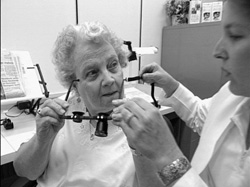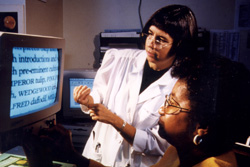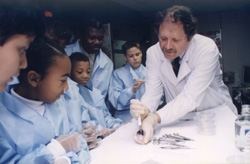National Plan for Eye and Vision Research
Low Vision and Blindness Rehabilitation
Visual impairment can be defined as any chronic visual deficit that impairs everyday functioning and is not correctable by ordinary eyeglasses or contact lenses. Visual impairment can be mild or moderate but also includes total blindness or functional blindness where no useful vision remains. Although there have been important strides over the past few decades in the treatment and prevention of eye diseases that cause visual impairment, there are still many causes of vision loss for which there is no cure. Even with the best medical treatment, many Americans live with impaired vision. In the United States, where normal vision is 20/20, legal blindness is defined as visual acuity with best correction in the better eye worse than or equal to 20/200 or a visual field extent of less than 20 degrees in diameter. In many States, a visual acuity of less than 20/40 disqualifies a person from obtaining a driver's license, as do some visual field deficits. Research in visual impairment and blindness is aimed at developing and assessing new methods for the rehabilitation of visually impaired individuals through assistive technologies, training, and rehabilitation services and education. Current estimates of the number of people who are visually impaired vary greatly by source and method of measurement, as well as by the inclusion criteria applied. Conservative estimates suggest that there are at least 3.5 to 5 million Americans who are visually impaired, and more than 1 million of these are legally blind. Because of the narrowly defined definitions of visual impairment, these figures undoubtedly underestimate the problem. However, many people experience functional limitations due to vision loss even though they do not meet the criteria for legal blindness. Even relatively mild impairment of vision can affect the performance of everyday tasks such as driving, reading, and walking. When more broadly defined as visual problems that hamper the performance and enjoyment of everyday activities, other recent estimates indicate that almost 14 million Americans suffer from visual impairment. Older adults represent the majority of the visually impaired population. Visual impairment is included among the 10 most prevalent causes of disability in the United States. The leading causes of visual impairment are diseases that are common in elderly persons, including AMD, glaucoma, DR, cataract, and optic nerve atrophy. More than two-thirds of people with visual impairment are older than 65 years of age. It is estimated that there were almost 34 million Americans older than age 65 years in 1992 and that by 2030 this number will more than double. Visual impairment in elderly persons decreases independence, increases the risk of falls and fractures, and often leads to isolation and depression. The leading causes of visual impairment in infants and children are retinopathy of prematurity, deficits in the visual centers of the brain, and structural ocular abnormalities such as cataract and retinal abnormalities. These conditions sometimes have a severe impact on children's quality of life, especially when vision impairment coexists with other impairments, and can have major consequences on education and future opportunities for employment. However, children, like adults, benefit significantly from coordinated and comprehensive services to ameliorate disability.
The next 5 years of research on visual impairment and blindness and their rehabilitation can lead to great strides in improving the quality of life for visually disabled people. These accomplishments can be realized if the existing research infrastructure is enhanced and if there is a broad-based program to educate clinicians, neuroscientists, and engineers from a variety of backgrounds about the research opportunities in low vision and blindness rehabilitation. The points below are not meant to reflect all opportunities for ameliorating visual impairment. However, they represent a sample of the many opportunities that exist for enriching the base of knowledge in the research and clinical communities and for assisting people with low vision and blindness in improving the quality of their lives. After a thorough evaluation of the entire Program, the Low Vision and Blindness Rehabilitation Panel recommends the following goals for the Program for the next 5-year period:
Important advances have been made in the past 5 years that influence visual impairment and rehabilitation. Psychometric measures for characterizing disability and assessing quality of life issues have improved. This has helped researchers recognize the importance of psychosocial factors in vision loss, and the new measures have been applied to rehabilitation research for evaluating the outcomes of intervention programs. Technologies for low vision enhancement and wayfinding have continued to improve, allowing for advances in mobility research on ways people with normal vision and visual impairment get around using visual, auditory, and haptic cues from the environment. Cognitive factors based on perception of the environment also play an important navigational role in walking and driving. Progress has been made in leveraging mainstream technologies for people with visual impairments. Accessibility requirements have been incorporated into World Wide Web standards, text-to-speech and speech-to-text software programs have improved, and magnified text is available on most computers. New embossing technologies that produce dynamic tactile cues give people who are blind better access to graphics. There has been progress in the development and deployment of assistive aids such as the global positioning system-based navigation system, talking signs, auditory signals at street crossings, and barcoding schemes for labeling locations and objects. These location-aware technologies provide detailed information about the environment and a person's whereabouts. Portable assistive devices that enhance residual vision also represent important gains. Some progress has also been made in the development of assistive intraocular aids such as the implantable monocular telescope. fMRI and other imaging technologies have increased the understanding of changes in the brain related to visual deficits and impairments. Researchers are continuing to learn about the organization of the brain, which may have implications for rehabilitative training and device development. Research has identified the incidence of visual impairment in certain segments of the population and its effect on mortality. Earlier epidemiological research revealed that functional impairment and disability from low vision and blindness were much more prevalent than had been thought. More recently, populations have been identified in which visual impairment occurs most frequently. It was learned that visual impairment occurs mostly among people who are underserved by the health care system and among members of minority groups. Additionally, it has been learned that visual impairment is linked to increased mortality independent of comorbid conditions. This research has direct implications for health care planning and public health policy. There has been progress in raising awareness of visual impairment and rehabilitation. Education and outreach programs in schools, community centers, and elsewhere are teaching ways to prevent vision loss and manage visual impairment. Well-written and targeted educational materials, many on the Web, are helping convey the message that progress is being made to understand and overcome vision loss and develop technologies for managing visual impairment.
On the basis of a review of the research advances that have been made in this Program and an analysis of the current research needs and opportunities, the Low Vision and Blindness Rehabilitation Panel recommends the following laboratory and clinical research objectives:
|


